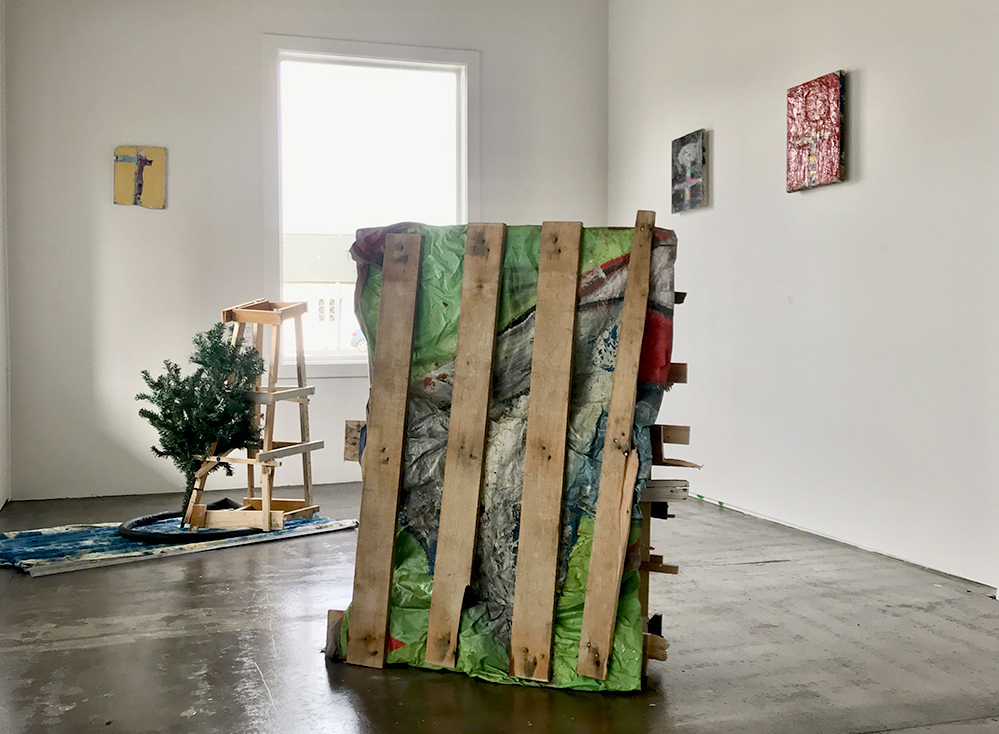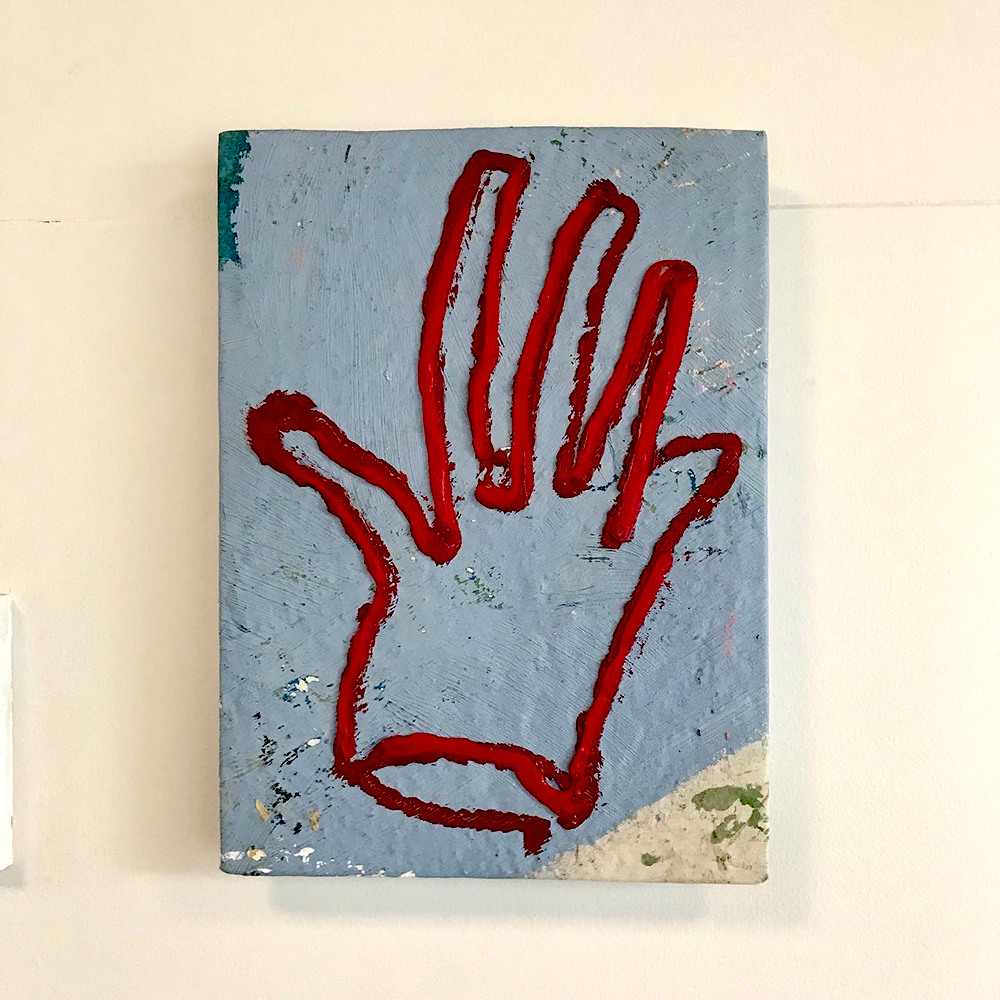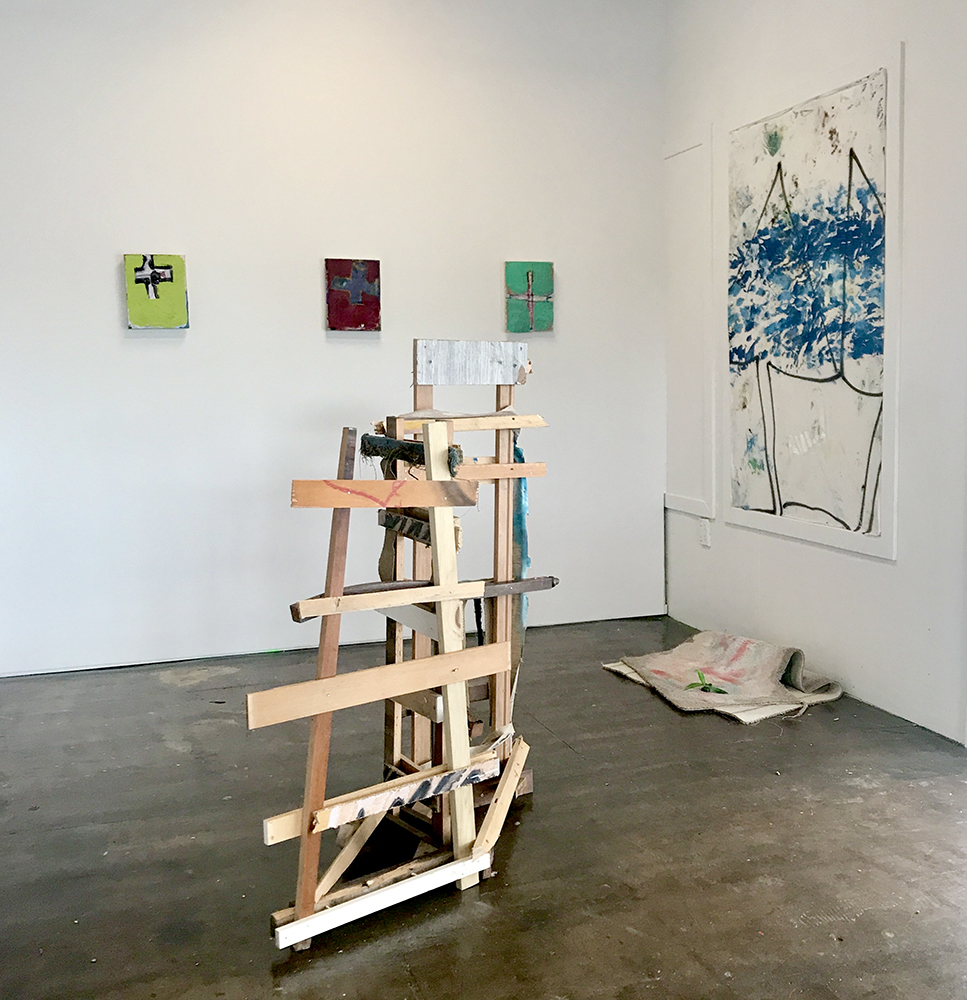
Flotsam
Exhibition by Gareth Brighton
Flotsam | Gareth Brighton | 18a, Whakatū
14.10.22 | written by Linda Dimitrievski
I love scouring my local beach after a big storm; there is a certain excitement to seeing what has been washed up after some rough weather. Battered ply, seasoned by wind and sea is a particular score. Mussel buoys, the jackpot as these things go. There are the little treasures as well, sea glass, strangely shaped driftwood, seaweed for the garden. In my small coastal community there is another kind of flotsam. People of all kinds get washed up here, some for a short time, carried away by the next tide, others who stay, coming to rest above the high tide mark. Seemingly random, the winds and currents of our lives deposit us on the rocky shore to be picked up or carried away.
With these notions of unexpected, washed up treasures, it is with curiosity and anticipation I wander down to Whakatū’s excellent independent project space, 18a, to experience Gareth Brighton’s Flotsam. Brighton’s take on the subject originates not from the shore but from the streets — the things people leave behind, their abandoned stories. In this instance he has taken these mementos and rebuilt fragmented tales into a new whole; communicating cohesive, if elusive, thoughts through found, broken objects haphazardly put together.
With these notions of unexpected, washed up treasures, it is with curiosity and anticipation I wander down to Whakatū’s excellent independent project space, 18a, to experience Gareth Brighton’s Flotsam. Brighton’s take on the subject originates not from the shore but from the streets — the things people leave behind, their abandoned stories. In this instance he has taken these mementos and rebuilt fragmented tales into a new whole; communicating cohesive, if elusive, thoughts through found, broken objects haphazardly put together.

Angel. Acrylic paint and paint pen on fabric wrapped board with wooden stand.
The space is small, as galleries go, with windows and doors punctuating the wall space, droplets of paint staining the floor, creeping up on the wall. It is worn, it is punk, flicking the bird at convention—Brighton’s work fits right in.
The floorspace is awash with unexpected pairings and curiously assembled structures. Bits of pallets paired with a defunct chair here; over there a piece of old carpet with a sprig of cheerful green leaves. Sharp angles and rough surfaces. Like pubescent teenagers begging to be seen while shouting profanities, the pieces plead for your attention whilst rejecting your sensibilities. They want to be heard, have their existence recognized and the stories they tell validated — yet they try to repel you with their shabby, battered exteriors.
Hanging above, safely distanced from this cacophony, Brighton’s iconic paintings stand like sentinels on guard. Most of them depict various cross-shapes, some have heads, others float on fields of colour. The paint is applied thickly over stretched scraps of found clothing and fabric, continuing the story of human debris that infuses the space. Positioned above the constructs on the floor, they seem at first benevolent. But I soon wonder if these sentinels are indifferent spectators to the hormone-driven identity crisis and angst acted out below. Propped up on the floor, among the material chaos, is Angel, a piece with which I feel a real affinity. There, in the thick of it, Angel appears to cast judgement upon its wall-hung fellows.
The floorspace is awash with unexpected pairings and curiously assembled structures. Bits of pallets paired with a defunct chair here; over there a piece of old carpet with a sprig of cheerful green leaves. Sharp angles and rough surfaces. Like pubescent teenagers begging to be seen while shouting profanities, the pieces plead for your attention whilst rejecting your sensibilities. They want to be heard, have their existence recognized and the stories they tell validated — yet they try to repel you with their shabby, battered exteriors.
Hanging above, safely distanced from this cacophony, Brighton’s iconic paintings stand like sentinels on guard. Most of them depict various cross-shapes, some have heads, others float on fields of colour. The paint is applied thickly over stretched scraps of found clothing and fabric, continuing the story of human debris that infuses the space. Positioned above the constructs on the floor, they seem at first benevolent. But I soon wonder if these sentinels are indifferent spectators to the hormone-driven identity crisis and angst acted out below. Propped up on the floor, among the material chaos, is Angel, a piece with which I feel a real affinity. There, in the thick of it, Angel appears to cast judgement upon its wall-hung fellows.
 Coding. Oil paint on fabric wrapped board.
Coding. Oil paint on fabric wrapped board. Nothing is firmly anchored. New layers continuously float to the surface, soon to be washed away to allow another revelation — or revolution — to come to light. The conversation between the anguish playing out at ground level and the apathetic paintings on the walls shift and change as new impressions emerge. One painting, Health and Safety, has nails smashed through from behind, questioning the veracity of its proclaimed name—a crown of thorns? Another, the red hand, paint applied straight from tube to canvas, hangs among the aloof icons, putting a sinister spin to the spiritual overtones, and bringing the political to the religious.
The exhibition integrates criticism and playfulness in a way that keeps me returning to its various components, watching, listening, eager for what will be disclosed next. Expansion and Gift are in cahoots by the door while Standing joke nonchalantly leans against the wall, talking away with some stray spray paint left behind on the floor. Etymology, a piece of an old Christmas tree propped up by a rickety scaffold, is doing her own thing, sailing off on a sea of corrugated iron, flicking a dismissive finger at anyone who might care to notice.
The exhibition integrates criticism and playfulness in a way that keeps me returning to its various components, watching, listening, eager for what will be disclosed next. Expansion and Gift are in cahoots by the door while Standing joke nonchalantly leans against the wall, talking away with some stray spray paint left behind on the floor. Etymology, a piece of an old Christmas tree propped up by a rickety scaffold, is doing her own thing, sailing off on a sea of corrugated iron, flicking a dismissive finger at anyone who might care to notice.
 Gareth Brighton, Flotsam, 2022. Installation view.
Gareth Brighton, Flotsam, 2022. Installation view. Here, Brighton’s exploration of street-side flotsam translates to a commentary of contemporary human experience. There are challenges that have surfaced over the last few years, particularly with regards to physical distancing and isolation, creating rifts and uncertainties with effects of which we can’t predict. Children, who can’t settle as they never know what disruptions are next, are growing into anxious adolescents; discarded youth, pushed by winds and waves, deposited on a precarious beach with a dystopian future lurking behind the hills. I look to the indifferent paintings hoping for an alternative end. Expansion bolsters my battered heart and Etymology’s rebellious spirit implies the possibility of a different conclusion.
I used the word “haphazardly” before, indicating my first impression. There is nothing haphazard about this installation. Each work holds its own, resolved in execution, to be completed by the viewer. The dialogue between the pieces ebb and flow, bouncing around the space in a continuous give and take. A point of exchange, skilfully guided by Brighton’s creative dexterity but we are given no conclusion save for whatever hope we might carry with us.
I leave, questioning not just the state of the society in which I live but my own complicity in its formation and continuation. Unlike flotsam, I can choose to not be passively carried by the changing tides.
Gareth Brighton, Flotsam, 2022. 06 August – 24 September 2022 at 18a, Whakatū Nelson.
All works made by Gareth Brighton, 2022.
Photos: By 18a, courtesy of 18a and the artist.

Article image: Gareth Brighton, Flotsam, 2022. Installation view.
I used the word “haphazardly” before, indicating my first impression. There is nothing haphazard about this installation. Each work holds its own, resolved in execution, to be completed by the viewer. The dialogue between the pieces ebb and flow, bouncing around the space in a continuous give and take. A point of exchange, skilfully guided by Brighton’s creative dexterity but we are given no conclusion save for whatever hope we might carry with us.
I leave, questioning not just the state of the society in which I live but my own complicity in its formation and continuation. Unlike flotsam, I can choose to not be passively carried by the changing tides.
Gareth Brighton, Flotsam, 2022. 06 August – 24 September 2022 at 18a, Whakatū Nelson.
All works made by Gareth Brighton, 2022.
Photos: By 18a, courtesy of 18a and the artist.
Article image: Gareth Brighton, Flotsam, 2022. Installation view.
ISSN 2744-7952
Thank you for reading ︎
Vernacular logo designed by Yujin Shin
vernacular.criticism ︎

